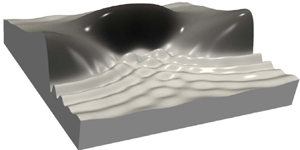Article contents
Three-dimensional dynamics of falling films in the presence of insoluble surfactants
Published online by Cambridge University Press: 13 November 2020
Abstract

We study the effect of insoluble surfactants on the wave dynamics of vertically falling liquid films. We use three-dimensional numerical simulations and employ a hybrid interface-tracking/level-set method, taking into account Marangoni stresses induced by gradients of interfacial surfactant concentration. Our numerical predictions for the evolution of the surfactant-free, three-dimensional wave topology are validated against the experimental work of Park & Nosoko (AIChE J., vol. 49, 2003, pp. 2715–2727). The addition of surfactants is found to influence significantly the development of horseshoe-shaped waves. At low Marangoni numbers, we show that the wave fronts exhibit spanwise oscillations before eventually acquiring a quasi-two-dimensional shape. In addition, the presence of Marangoni stresses is found to suppress the peaks of the travelling waves and preceding capillary wave structures. At high Marangoni numbers, a near-complete rigidification of the interface is observed.
Information
- Type
- JFM Papers
- Information
- Copyright
- © The Author(s), 2020. Published by Cambridge University Press
References
REFERENCES
- 10
- Cited by


